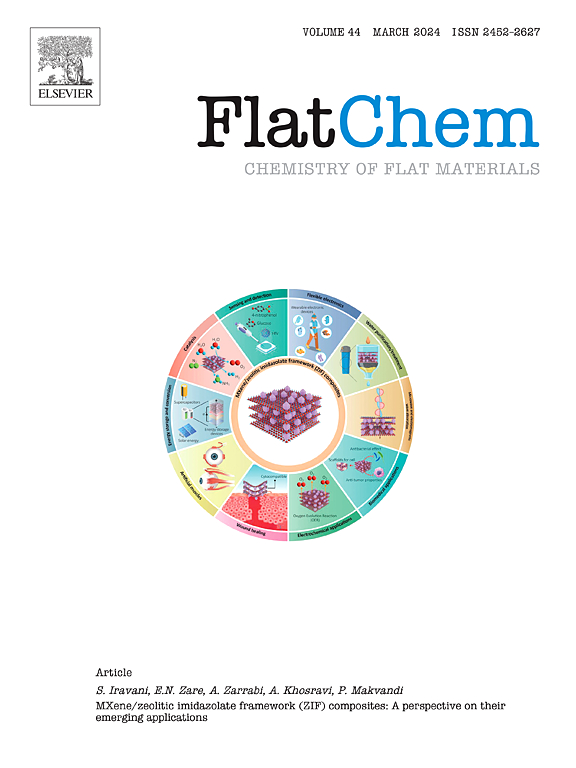Visible light-driven degradation of Brilliant Green and Indigo Carmine organic contaminants using SnS2/GCN/rGO and CuS/GCN/rGO ternary composites – A comparative study
IF 5.9
3区 材料科学
Q2 CHEMISTRY, PHYSICAL
引用次数: 0
Abstract
This study introduces novel SnS2/GCN/rGO and CuS/GCN/rGO ternary composites for the visible-light-driven degradation of organic contaminants, specifically targeting the dyes Brilliant Green (BG) and Indigo Carmine (IC). X-ray diffraction (XRD), Fourier Transform Infrared Spectroscopy (FTIR), Scanning Electron Microscopy (SEM-EDS), UV–visible, Photoluminescence (PL), and impedance spectroscopy were used to characterize the synthesized samples to extract the characteristic features of the catalysts. The chemical compositions of synthesized samples were confirmed using X-ray photoelectron spectroscopy (XPS). The ternary composite SnS2/GCN/rGO revealed the degradation of BG by 98.0 % and IC by 80.9 %. CuS/GCN/rGO composite has shown degradation efficiencies of 92.7 % for BG and 78.5 % for IC. Unlike previous approaches, this work provides a comparative analysis of SnS2 and CuS-based ternary systems, emphasizing their distinct photocatalytic mechanisms Z-scheme in SnS2/GCN/rGO and direct electron transfer in CuS/GCN/rGO. By integrating GCN and rGO, this study addresses the typical limitations of metal sulfides, such as rapid charge recombination, enhanced electron mobility, and overall degradation efficiency under visible light. The confirmation of degradation species is made using chemical oxygen demand (COD) measurements. These results were supported by the reduction in the photoluminescence intensity and lower charge transfer resistance by impedance spectra suggesting an enhanced degradation rate for the ternary composites.

SnS2/GCN/rGO和cu /GCN/rGO三元复合材料可见光降解亮绿和靛胭脂有机污染物的比较研究
本研究介绍了一种新型的SnS2/GCN/rGO和cu /GCN/rGO三元复合材料,用于可见光降解有机污染物,特别是针对染料Brilliant Green (BG)和Indigo Carmine (IC)。采用x射线衍射(XRD)、傅里叶变换红外光谱(FTIR)、扫描电子显微镜(SEM-EDS)、紫外可见、光致发光(PL)和阻抗谱对合成的样品进行表征,提取催化剂的特征特征。用x射线光电子能谱(XPS)确定了合成样品的化学成分。三元复合材料SnS2/GCN/rGO对BG的降解率为98.0%,对IC的降解率为80.9%。cu /GCN/rGO复合材料对BG的降解效率为92.7%,对IC的降解效率为78.5%。与之前的方法不同,本研究对SnS2和基于cu的三元体系进行了比较分析,强调了它们不同的光催化机制——SnS2/GCN/rGO中的Z-scheme和cu /GCN/rGO中的直接电子转移。通过整合GCN和rGO,本研究解决了金属硫化物的典型局限性,如快速电荷重组、增强电子迁移率和可见光下的整体降解效率。使用化学需氧量(COD)测量来确定降解种类。这些结果得到了光致发光强度降低和电荷转移电阻降低的支持,表明三元复合材料的降解率提高。
本文章由计算机程序翻译,如有差异,请以英文原文为准。
求助全文
约1分钟内获得全文
求助全文
来源期刊

FlatChem
Multiple-
CiteScore
8.40
自引率
6.50%
发文量
104
审稿时长
26 days
期刊介绍:
FlatChem - Chemistry of Flat Materials, a new voice in the community, publishes original and significant, cutting-edge research related to the chemistry of graphene and related 2D & layered materials. The overall aim of the journal is to combine the chemistry and applications of these materials, where the submission of communications, full papers, and concepts should contain chemistry in a materials context, which can be both experimental and/or theoretical. In addition to original research articles, FlatChem also offers reviews, minireviews, highlights and perspectives on the future of this research area with the scientific leaders in fields related to Flat Materials. Topics of interest include, but are not limited to, the following: -Design, synthesis, applications and investigation of graphene, graphene related materials and other 2D & layered materials (for example Silicene, Germanene, Phosphorene, MXenes, Boron nitride, Transition metal dichalcogenides) -Characterization of these materials using all forms of spectroscopy and microscopy techniques -Chemical modification or functionalization and dispersion of these materials, as well as interactions with other materials -Exploring the surface chemistry of these materials for applications in: Sensors or detectors in electrochemical/Lab on a Chip devices, Composite materials, Membranes, Environment technology, Catalysis for energy storage and conversion (for example fuel cells, supercapacitors, batteries, hydrogen storage), Biomedical technology (drug delivery, biosensing, bioimaging)
 求助内容:
求助内容: 应助结果提醒方式:
应助结果提醒方式:


